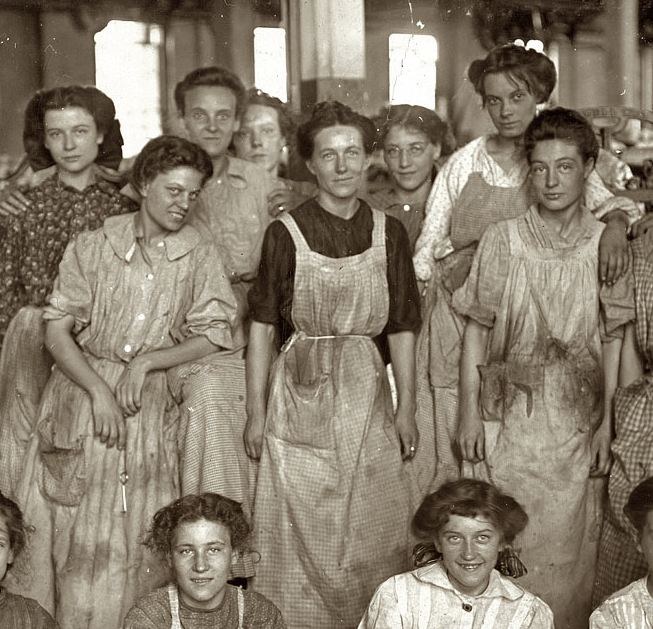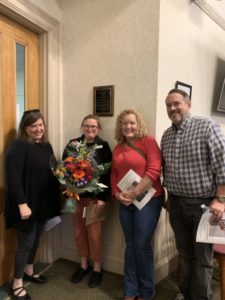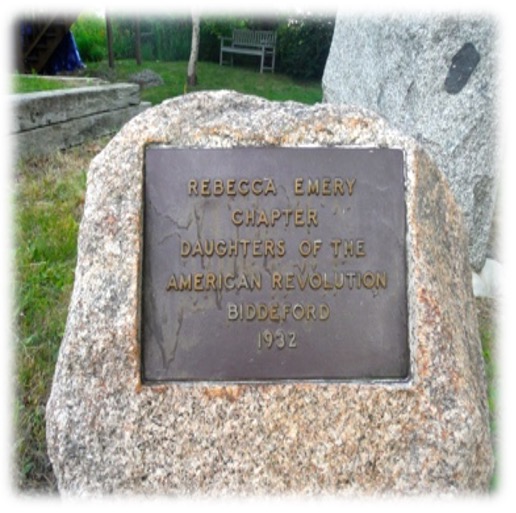2022 Biddeford Hall of Fame
Sarah Adams
Representing Biddeford Women Millworkers
Sarah Adams is the first name of 2750 female employees found in the first Saco-Biddeford Directory, published in 1849. Sarah Adams represented women’s labor, work that is often invisible but was critical to the success of Biddeford’s nineteenth-century economic growth and prosperity.
York Manufacturing Company produced 6,200,000 yards of cloth on 780 looms that year. The Laconia Company operated 1150 looms–looms that young women ran. Samuel Batchelder entered the Biddeford Hall of Fame in 2018; his success as Mill Agent rests in part on the labor of women.
Historian Laurel Thatcher Ulrich famously quipped that “well-behaved women seldom make history,” meaning that women who uphold cultural ideas of propriety, who do their duty and live their daily lives rarely receive mention in the historical record. Historians now look deeper into everyday women’s lives and the roles their daily duties played in American culture and their community; we broaden the definition to be more inclusive of the women, and many “well-behaved” men, who by simply living their daily lives, made “history.” As 2750 mill girls (and their mothers at home) illustrate, women’s daily labor in and out of the home is one of the foundations of society.
Sarah Adams and colleagues came to the mills to fill their time productively before marriage, to experience limited independence, to earn cash wages for the first time in American women’s history, to marvel at a new city and the goods and opportunities it had to offer or to put away money for themselves or their future families. These young women rewrote “women’s work.” And when the conditions of their work were unsatisfactory, these young women “turned out” and led Maine’s first labor strike (1841), raising an early voice for women’s and workers’ rights. The mills were powered by water and steam, but these young women were the engine of Biddeford’s tremendous economic success.



Renée Rurkett
Special Collections Librarian, Historian, Archivist


Renée has served the community as the Special Collections Librarian at McArthur Library since January 2007. Her responsibilities include the administration, management, and cataloging of all aspects of the Special Collections the library holds, including books, manuscripts, photographs, arts, artifacts, and maps. Her ability to assist library patrons, educate fellow team members, and champion Biddeford’s history in countless ways is truly astounding.
Whether connecting someone to a family member’s obituary previously impossible to find, or setting someone on a path to a lifelong curiosity in genealogy, she is the face of local history for McArthur Library.
She is passionate about peeling back the layers of time and bringing to life the local tapestry of characters, stories and contributions of immigrants, African Americans, indigenous peoples, and so many other populations who all too often have been under-represented by historical record.
Renée has painstakingly cataloged, stored, and shared Biddeford’s collections and archives. She has almost single-handedly made these items available to the amateur and the professional historian alike. Her interpretations and online exhibits reveal a professional historian’s and archivist’s knowledge of Biddeford’s priceless history.
Renée is well-regarded in her professional community and is currently the Vice President on the Board of Directors of the Maine Archives and Museum; she serves as an Advisory Committee Member of the Northeast Document Conservation Center and is the Maine representative to the “Lone Arrangers” section of the Society of American Archivists.
Locally, she serves on the Recycling and Waste Management Committee for the City of Biddeford. Renée received her BA degree in History from USM and an MS in Library and Information Science with an Archives concentration from Simmons University. She also holds an advanced level Public Librarian Certification.
Because of her caring nature, depth of knowledge, and incredible abilities, so much more is known about Biddeford’s history and so many individuals in our history will have their stories told, and their voices heard.

Rebecca Emery
March 7, 1697 - January 27, 1786
Tavern Owner, Midwife, Civic Minded
Rebecca Emery was born on March 7, 1697, in Berwick, Maine, then known as the Province of Massachusetts Bay. Rebecca was the granddaughter of Richard Hitchcock, who acquired his land from Richard Vines, on what is now Old Pool Road, Biddeford, Maine, then called Saco.
In 1719, at the age of twenty-two, Rebecca Emery married Captain Daniel Smith of Biddeford. Ten children would be born to them, and together, they ran a Tavern that was located on what was known as The King’s Highway that ran from Kittery to Portland passing by the Smith Tavern, in what was known as “Upper Biddeford.” Its location was near the present corner of Jefferson and South Streets in Biddeford.
Rebecca and Daniel’s Tavern was a site rich in both the business of the day, and the social center of Biddeford, as well as a historic setting for such dignitaries as, Sir William Pepperell, and James Sullivan. When Daniel died in 1752, Rebecca continued to run the Tavern. Three years later, Rebecca married Lt. Nathaniel Ladd. He continued to help Rebecca run the Tavern, which was then known as Ladd’s Inn, and she became known as Madame Ladd. Rebecca was highly respected and a noted Midwife and was often referred to as the “Grandmother of Biddeford and Saco” due to the many births she facilitated.
Rebecca lived a wholesome and giving life and passed away in 1786. She helped to produce a lineage that would go on to do countless and wonderful things in the Biddeford and Saco area. Remarkably, she had spent fifty years of her life living under the peril of regional war and conflict.
In 1896, daughter Cora Belle Bickford of Biddeford Pool, mobilized several women in the Biddeford-Saco area to discuss forming a local Chapter of the Daughters of the American Revolution, (DAR). Twelve women were in attendance and five of the twelve charter members were direct descendants of Rebecca Emery. In memory of Rebecca, the Rebecca Emery Chapter of the DAR was formed and then chartered on March 25, 1897. Over the years, the Rebecca Emery Chapter of the DAR has been responsible for the research and commemoration of a variety of local noteworthy places, important and notable people of the area, and historic events that have all served to enrich the antiquity and evolution of the Biddeford-Saco area up to its present time.
Ray Gagne
Fire Chief, Tireless Volunteer, Community Organizer
When Ray was young, his father owned a gas station/convenience store on Center Street near Elm Street. Spending much time there, he recalls the camaraderie of the people who were his father’s friends and customers. As an active boy, that time in his life shaped the active man he would become.
Ray was working as a milkman for Landry’s Dairy when Fire Commissioner Sheehan suggested that Ray join the call force on the fire department. He agreed and unbelievably, the first call he answered was the Hooper Street fire in 1963 and a month later the Grafton Lumber building burned. He became a full-time fire fighter later that year, was deputy chief for 18 years and chief for 10 years… a career that spanned a total of 40 years. In the early 1980s he and Ron Gagnon, from Biddeford High School, started a junior firefighter program and regularly had 15 or so students join the group, many of whom went on to be full time firefighters.
As a percussionist, Ray has played in many bands over the years. From the Swinging Hi-Lo’s in 1958 to the St. Louis Alumni Band to the band he is currently a part of in Florida. In 1965 he organized a 25-man drum and bugle corps, an unusual sound to hear from the fire station! They participated in various parades from Boston to Portland for many years.
Ray coached pee-wee football, youth hockey and created an Industrial League adult hockey team. In the late 1960s mayor Gil Boucher suggested that they put a broomball rink together at Rotary Park. He and others constructed the boards, built a rink, put-up lights and started a broomball league in Biddeford.
Ray and his wife Pat owned York County Pools on Alfred Street for 32 years. Pat handled the sales in the store and Ray sold and installed Pools around the area. Still looking for something to do in his spare time, Ray was recruited to join the LaKermesse organization in 1983, its first year. Here Ray hit his stride! For the next 40 years he became one of the most active members of LaKermesse. Early on, Ray used his job in the force to help the festival grow by establishing connections with various department heads and ensuring that there was a constant flow of communication between the town and festival planning committees. He started as a volunteer, taking an annual 2 week break from work to help with the festival, and eventually became field manager for four years. Gagne’s eventual transition to vice president of the LaKermesse festival was a natural step after so many years of experience.
Now retired, he can dedicate most of his time to LaKermesse and the City of Biddeford. The two go hand-in-hand and during the holiday season he and a group of volunteers can be found decorating Main Street with Christmas lights.
Following in his father’s footsteps, Ray’s son Scott is now the Fire Chief in Biddeford, making Ray a very proud man.


Bonita Pothier
First Woman Mayor, Educator, Civic Minded

On December 5, 1989, Bonita Pothier was sworn in as the first female mayor of Biddeford, Maine elected on the Democratic ticket. Pothier was a mom to three kids and owner of multiple businesses, which is enough reason to admire her accomplishments. Bonita Pothier also held the dual firsts of first female and first Franco President of the Biddeford-Saco Chamber of Commerce + Industry. And she brought recycling to Biddeford City Hall.
Bonita Pothier, since leaving office, has continued to distinguish herself in business and public service. She served as a Director of Saco’s Main St Maine organization, Saco Spirit, and served on the board of GrowSmart Maine. She spent nine years in leadership positions at Key Bank. Since 2013 she has served as the Regional Representative for Southern Maine in the office of U.S. Senator Angus King, conducting business and organizational outreach on the Senator’s behalf, among other duties.
Her groundbreaking work in local government politics in the 1980’s was studied and written about by the current mayor Alan Casavant. That detailed narrative, referenced here, is an incredible testament to the hurdles which was faced with, both from men and women. She faced down slurs from misogynists and cultural conservatives to blaze the way for future women mayors and we’d argue for women’s participation in all facets of local government and leadership organizations in Biddeford.
“Pothier’s role as a Franco mayor, mother, and wife would pervade every aspect of her new public life. During the campaign, she had heard “from ward clerks that some people voted against her because she was a woman.” Shockingly, even women voted against her because of their belief that women belonged in the home, not in the mayor’s chair. Pothier, however, considered her sex as an advantage in the political arena. She argued that she would engage problems differently than men, as women “attend to details and are more compassionate and tolerant, have high expectations and expect people to toe the line.” While men resented towing her line, women resented a woman who challenged that which they had never dared to do, breaking the shackles of cultural repression.
The years that have passed have opened the eyes to many within the community, who now see the Pothier years, devoid of newspaper caricature or character assassination, as being a catalyst for Biddeford’s modernization. A descendant of French-Canadian women, who were sent to Quebec to be wives, mothers, and property, who crossed the border to work a lifetime in noisy, brick mills, she was an epiphany! She was the first!”
Moses W. Webber
August 25, 1837 - June 20, 1899
Visionary, Benefactor of Webber Hospital
Moses was born in Springvale, Maine, a son of Aaron Webber and Harriet Masen. On his Civil War draft form of July 1, 1863, he was listed as 23 years old and an operative (likely at a mill) from Biddeford. He married Eliza P Littlefield of Saco in June of 1869, moving to High Street in Biddeford.
When Moses died in 1899, he bequeathed $40,000 in memory of his wife Eliza toward a free hospital for the people of Biddeford “where the unfortunate may receive good care and skillful treatment.” The first Webber Hospital opened in 1906 at the former home of Josephine L. Freeman at 143 Pool Road where it remained until the opening of a modern, state-of-the-art brick building on Elm Street in 1911.
The Webber Hospital was the first Allopathic Hospital in Biddeford, where doctors were licensed with medical degrees as M.D.s. At one time they had their own nursing school and many local women have memories of working on Elm Street as a candy striper.
In 1979 a new hospital was built on Alfred Street and named Southern Maine Health Care but many still refer to it as “The Webber Hospital” out of many years of habit.
Moses, who had been overseer of the Pepperell cloth room and paymaster of the Laconia division, eventually left Biddeford to work in New Hampshire. Because of his foresight and generosity, Biddeford had a first-class health care facility which continues today to care for the community. Many were born and died there, many had surgeries or injuries and were treated there and many are employed there today and have made a community of friends as a result of Moses W. Webber.

